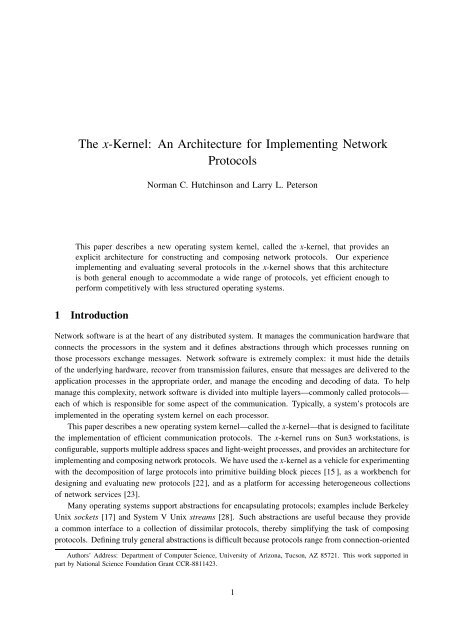The x-Kernel: An architecture for implementing network protocols - IDA
The x-Kernel: An architecture for implementing network protocols - IDA
The x-Kernel: An architecture for implementing network protocols - IDA
Create successful ePaper yourself
Turn your PDF publications into a flip-book with our unique Google optimized e-Paper software.
<strong>The</strong> x-<strong>Kernel</strong>: <strong>An</strong> Architecture <strong>for</strong> Implementing Network<br />
Protocols<br />
Norman C. Hutchinson and Larry L. Peterson<br />
This paper describes a new operating system kernel, called the x-kernel, that provides an<br />
explicit <strong>architecture</strong> <strong>for</strong> constructing and composing <strong>network</strong> <strong>protocols</strong>. Our experience<br />
<strong>implementing</strong> and evaluating several <strong>protocols</strong> in the x-kernel shows that this <strong>architecture</strong><br />
is both general enough to accommodate a wide range of <strong>protocols</strong>, yet efficient enough to<br />
per<strong>for</strong>m competitively with less structured operating systems.<br />
1 Introduction<br />
Network software is at the heart of any distributed system. It manages the communication hardware that<br />
connects the processors in the system and it defines abstractions through which processes running on<br />
those processors exchange messages. Network software is extremely complex: it must hide the details<br />
of the underlying hardware, recover from transmission failures, ensure that messages are delivered to the<br />
application processes in the appropriate order, and manage the encoding and decoding of data. To help<br />
manage this complexity, <strong>network</strong> software is divided into multiple layers—commonly called <strong>protocols</strong>—<br />
each of which is responsible <strong>for</strong> some aspect of the communication. Typically, a system’s <strong>protocols</strong> are<br />
implemented in the operating system kernel on each processor.<br />
This paper describes a new operating system kernel—called the x-kernel—that is designed to facilitate<br />
the implementation of efficient communication <strong>protocols</strong>. <strong>The</strong> x-kernel runs on Sun3 workstations, is<br />
configurable, supports multiple address spaces and light-weight processes, and provides an <strong>architecture</strong> <strong>for</strong><br />
<strong>implementing</strong> and composing <strong>network</strong> <strong>protocols</strong>. We have used the x-kernel as a vehicle <strong>for</strong> experimenting<br />
with the decomposition of large <strong>protocols</strong> into primitive building block pieces [15 ], as a workbench <strong>for</strong><br />
designing and evaluating new <strong>protocols</strong> [22], and as a plat<strong>for</strong>m <strong>for</strong> accessing heterogeneous collections<br />
of <strong>network</strong> services [23].<br />
Many operating systems support abstractions <strong>for</strong> encapsulating <strong>protocols</strong>; examples include Berkeley<br />
Unix sockets [17] and System V Unix streams [28]. Such abstractions are useful because they provide<br />
a common interface to a collection of dissimilar <strong>protocols</strong>, thereby simplifying the task of composing<br />
<strong>protocols</strong>. Defining truly general abstractions is difficult because <strong>protocols</strong> range from connection-oriented<br />
Authors’ Address: Department of Computer Science, University of Arizona, Tucson, AZ 85721. This work supported in<br />
part by National Science Foundation Grant CCR-8811423.<br />
1

















